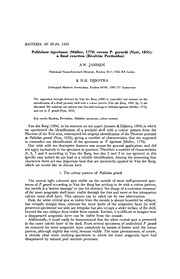
Palliolum tigerinum (Müller, 1776) versus P. gerardi (Nyst, 1835): a final reaction (Bivalvia: Pectinidae) PDF
Preview Palliolum tigerinum (Müller, 1776) versus P. gerardi (Nyst, 1835): a final reaction (Bivalvia: Pectinidae)
BASTERIA, 60: 83-84, 1996 Palliolumtigerinum (Müller, 1776) versus P. gerardi (Nyst, 1835): a final reaction (Bivalvia: Pectinidae) A.W. Janssen NationaalNatuurhistorisch Museum, Postbus9517, 2300RALeiden & H.H. Dijkstra Zoologisch MuseumAmsterdam,Postbus 94766, 1090GTAmsterdam The arguments broughtforward by Van derBurg (1996) tocontradict ouropinionon the identification ofa fossil pectinid shellwitha colourpattern (Vander Burg, 1995,fig. 1)are discussed. We maintain ouropinionthat this shell belongstoPalliolum tigerinum(Müller,1776), and notto P. gerardi(Nyst, 1835). Key words: Bivalvia,Pectinidae, Palliolum,taxonomy, colour pattern. VanderBurg (1996), inhisreaction onourpaper (Janssen &Dijkstra, 1996) in which we questioned the identificationof a pectinid shell with a colour pattern from the Plioceneofthe Peel area, maintainedhis original identificationofthe Pliocene pectinid as Palliolumgerardi (Nyst, 1835), giving a number of characteristics that are supposed to contradict our identificationofthe specimen as P. tigerinum (Miiller, 1776). Our table with ten descriptive features was meant for general application, and did notapplyexclusively to thespecimen in question. Thereforea numberofcharacteristics (4, 5, 7 and 9 according to Van der Burg, but also 2 and 3 in our opinion) in this specific case indeed donot lead to a reliableidentification.Among theremaining four characters there are two important facts that are incorrectly applied by Van derBurg, which we would like to discuss here. 1. The colourpattern of Palliolumgerardi The central light colouredspot visible on the outside of most well-preserved spec- imensof P. gerardiaccording toVan der Burg has nothing to do with a colourpattern, butmerely is a 'mirrorimmage' or(see hisabstract) 'the image ofa corrosionremnant' oftheinner aragonitic shell layer, visiblethrough the thinandmoreor less transparent calcitic outer shell layer. This opinion can be ruled out by two observations. First, thewhite centralspot as visiblefrom theoutside is always boundedby oblique, but virtually straight lines, whereas the inner limits ofthe aragonitic layer (in well- preserved specimens) notonly are irregular butalso occupy awider surfaceoftheshell, beyond thetwo oblique linesvisiblefromoutside. Further, itis difficultto imagine how a disappeared aragonitic layer can be visible from the outside. Additionally, it couldeasily be demonstratedthatthe whitecentral spot is preserved in the outer calcitic layer ofthe shell. From several specimens ofundoubted P. gerardi we removedthe inner aragonitic layer completely by meansofformic acid: the colour pattern, although slightly less vivid,remains visible. The samephenomenon, ofcourse, is already clear when studying specimens in which the inner aragonitic layer had disappeared by natural post mortem processes. 84 BASTERIA, Vol. 60, No. 1-3, 1996 Exactly the same results were obtained, by theway, by a treatmentwithformic acid ofidentically colouredspecimens ofAmusium cristatum (Bronn, 1827) from the Pliocene of northern Italy. After all, even if Van der Burg is right in writing that the white central spot of P. gerardiis notacolourpattern, this feature is never found in P. tigerinum, and therefore, if present, is a reliable distinguishing characteristic between these two taxa. 2. Measurementofthe umbonal angle The umbonal angle ofthe illustratedspecimen (Van der Burg, 1995: 30, fig. 1) is 90° when the early growth stage is measured. Inlater ontogeny the sutures are anti- marginally slightly diverged, enclosing an umbonalangle ofover 100°. The value of 90°, as found in Van der Burg's specimen is, admittedly, somewhat larger than in 'typical' P. tigerinum, although examinedRecentmaterialofP. tigerinum f. laevis (Pennant, 1777) from the Irish Sea and from the English Channel(Dijkstra collection, 21 spec- imens) issimilartoVanderBurg's illustratedspecimen (similarumbonalangle, sculpture and colour pattern). Our table should be adjusted in this respect! Among the remaining characters, as discussed by Van der Burg in his application ofourtable, no. 1 is ofrelativevalue only and depends onpersonal interpretation, no. 2 is validfor both species. The differencesin convexity, given as no.3, are especially meant for articulated specimens and are ofrestricted value for isolated valves. The radialriblets onthe anteriorauricle(no. 6) ofVan derBurg's specimen arealso similar to those in P. tigerinum (more prominent and less in number than in P. gerardi). Finally, in his 'Application ofthe table ofJanssen & Dijkstra' Van der Burg states underno. 10 that his specimens show 'no maculations....', which is curious, as these are clearly visible in his first illustration, and in fact, were the reason for his paper on the subject. Such maculations do not occur in P. gerardi, but are well-known from a numberof Recentpectinids (Van derBurg rightly referred toAbbott&Dance, 1991). Among the related pectinids from the North Sea Basin's Pliocene, however, it is only P. tigerinum in which such maculations are known. Van der Burg's paper records the first obser- vation ofthis colourpattern in fossil material ofthat species. The new illustrations given by Van der Burg (1996, figs. 1 and 3) indeedrepresent P. gerardi,butforthe reasons stated above, we maintainour identificationofP. tigerinum for the specimen with the colourpattern (Van der Burg, 1996, fig. 2). This opinion still is based only on Van der Burg's illustrations, as the specimen in question has not been madeavailable to us. REFERENCES BURG, W.J. VAN DER, 1995. Remnants ofacolourpattern onPseudamussium gerardi(Nyst) (Bivalvia: Pectinidae)fromthePliocene ofthenorthern Peel district,theNetherlands).—Basteria59: 29-30. —, 1996.The identity ofafossil valve withacolourpattern fromthePliocene ofthenorthernPeel district, theNetherlands. — Basteria60: 79-82. JANSSEN, A.W., &H.H. DIJKSTRA, 1996. Morphologicaldifferences betweentwo species ofPalliolum (Bivalvia:Pectinidae).— Basteria 59: 107-113.
